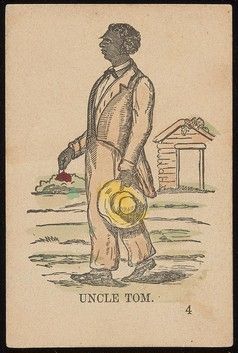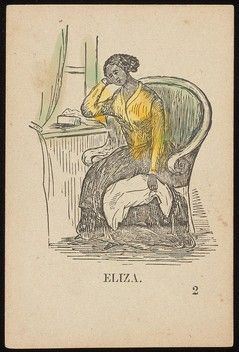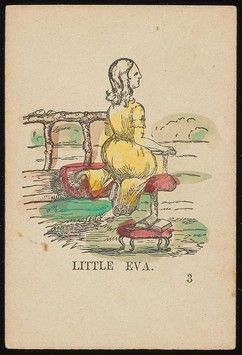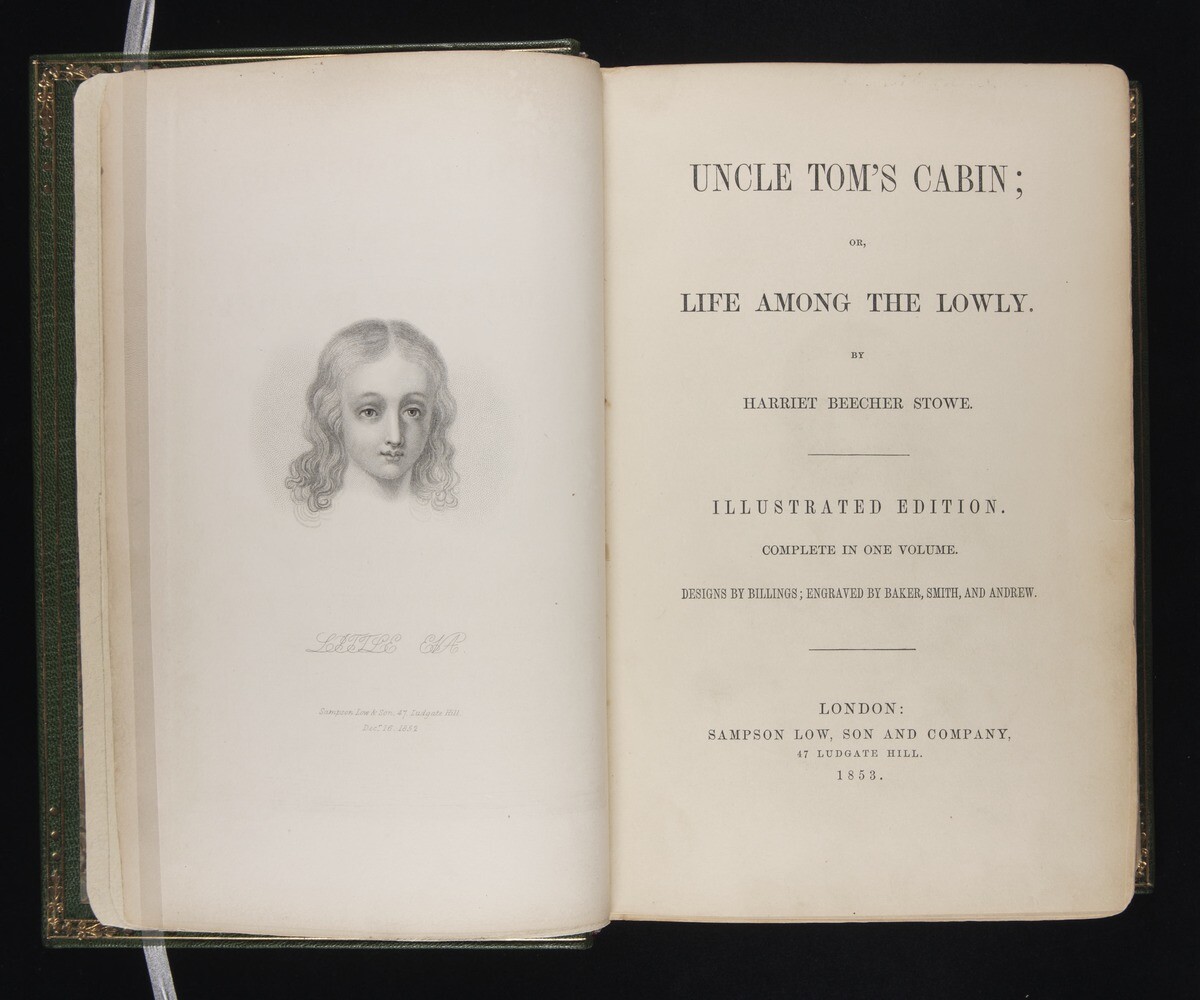Harriet Beecher Stowe’s novel, Uncle Tom’s Cabin, is unique in 19th century American print culture. It played an important role in abolitionist movements of the period and it was a popular sensation—songs, stage plays, children’s books, and parlor games allowed readers to encounter the work and its characters in an unprecedented array of formats.
Materials in the Beinecke Library collections related to the novel offer opportunities to consider the publication and reception of this exceptional work and to explore aspects of 19th century American print culture.
An illustrated history of the novel and its reception can be found on the Beinecke Library’s wesite: The Life of Uncle Tom.
Timeline | British Imprints | Additional Resources
Timeline

Timeline excerpted from Kendra Hamilton’s “The Strange Career of Uncle Tom: on the 150th Anniversary of the Publication of Uncle Tom’s Cabin, Scholars Reflect on the Legacy of the Groundbreaking Novel and its Author Harriet Beecher Stowe,” in Black Issues in Higher Education, June 6, 2002, 19.8, p. 22.
Selected titles in the Beinecke Library have been added in bullet points, with call numbers in bold and relevant library catalogues and online resources linked.
1850: Passage of the Fugitive Slave Law, requiring all citizens to return runaway slaves to their owners, becomes a major catalyst for Harriet Beecher Stowe’s antislavery writing.
1851: Uncle Tom’s Cabin is serialized in The National Era, an abolitionist newspaper.
- The National Era, 5 June 1851. Zza Zn 215 v. 5 (Issues of the National Era are available online via Proquest.)
1852: Uncle Tom’s Cabin is published as a two-volume book, precipitating a wave of “anti-Tom” novels defending the South, an enormously profitable merchandising movement and stage adaptations that owed far more to the blackface minstrel tradition than to the ideas in the book.
- Stowe, Harriet Beecher. Uncle Tom’s Cabin, or, Life among the Lowly. Boston: J. P. Jewett, 1852. Za St78 852. Selected images available in the digital library. (Full text online in Quicksearch)
- Criswell, Robert. Uncle Tom’s Cabin Contrasted with Buckingham Hall, the Planter’s Home: or A Fair View of Both Sides of the Slavery Question. New York: Fanshaw, 1852. JWJ Za C868 852u (Full text online in Quicksearch)
- “The Game of Uncle Tom,” card game. Rhode Island: V. S .W. Parkhurst, 1852. Card Playing Card Collection, USA 185 / Shirley 5552 & online in digital collections
- “The Death of St. Clare: Little Eva’s Father, founded upon a scene in Uncle Tom’s Cabin,” poem by M. A. Collier, adapted to a favorite melody. Boston: Oliver Ditson, [1852]. Shirley +84 (Full text online)
- Howard, F. “Uncle Tom’s Glimpse of Glory.” Boston: Wade, c1852. Za1 +G1 Stowe (Full text online)
- Smith, W. L. G. Life at the South, or, “Uncle Tom’s Cabin” as it is: Being Narratives, Scenes, and Incidents in the Real “Life of the Lowly.” Buffalo: G. H. Derby and Co., 1852. JWJ Za Sm68 852L (Full text online)
- Aiken, George L. Uncle Tom’s Cabin: or, Life Among the Lowly, A Domestic Drama in Six Acts. New York: S. French, [18–]. 2016 983 (Full text online)
- Emilio, M. “Little Eva: Song (Little Eva, Uncle Tom’s Guardian Angel).” Boston: Jewett, c1852. Za St78 +G852E (Full text online)
- Waddell, James A. “Uncle Tom’s cabin” reviewed; or, American society vindicated from the aspersions of Mrs. Harriet Beecher Stowe Printed at the Office of the “Southern Weekly Post,” 1852. JWJ Za St78 Tu852W (Partial text online)
- Porcelain figures: Topsy & Eva [Staffordshire, England : s.n., circa 1852-1860?]. Art Storage 925 & online in digital collections
- Boston Museum 10th Season: 6th Week of the New and Intensely Interesting Play, Uncle Tom’s Cabin! 1852. BrSides Folio 2014 194 (Full text online)
1853: A Key to Uncle Tom’s Cabin is published to corroborate the facts of the novel; George Aiken’s unauthorized stage version takes the nation by storm.
- Stowe, Harriet Beecher. A Key to Uncle Tom’s Cabin; Presenting the Original Facts and Documents upon which the Story is Founded. Together with Corroborative Statements Verifying the Truth of the Work. Boston, Jewett, 1853. Za St78 853k (Full text online)
- Little Eva: the Flower of the South. New York: Vincent L. Dill, [between 1853 and 1855?]. Shirley 1487 & 1488 (Full text online)
- Low, Mary. A Peep into Uncle Tom’s Cabin with an Address by Mrs. Harriet Beecher Stowe, to the Children of England and America. Boston: J. P. Jewett, 1853. Za St78 853L & online in digital collections (Full text online)
- Pictures and Stories from Uncle Tom’s Cabin, Boston: J. P. Jewett, [1853?]. Za St78 F853 (Full text online)
- Howard, G. “Eva to her Papa.” New York: Waters, c1853. Za St78 +G853 (Full text online) (Listen online)
- Porcelain jar decorated with two scenes from Uncle Tom’s cabin [1853-1865?], Boston: Jewett, 1853. Art Storage 926 & online in digital collections
- “Mrs. Keeley as Topsy. In the drama of ‘Slave life,’ or, ‘Uncle Tom’s Cabin’ as performed at the Theatre Royal Adelphi.” Stannard & Dixon, 1853. BrSides 2013 166 (Image available online.)
1854: T. D. Rice, the man who “invented” the Jim Crow dance, plays Tom in a New York production.
- Rice, Tom. “Jim Crow: Come Listen All You Galls and Boys I’s Jist from Tuckyhoe.” New York: E. Riley, [between 1819 and 1831]. 2001 Folio S8 V4 R357 J5643 (Full text online)
- Plate: Uncle Tom at home. [Staffordshire, England : s.n., 1855?]. Art Storage 927 & online in digital library
1856: The Dred Scott decision legalizes slavery in the territories; Stowe publishes her militant and neglected antislavery novel, Dred: A Tale of the Great Dismal Swamp.
1857: Sam Green, a free Black living in Maryland, is sentenced to 10 years in prison for owning a copy of Uncle Tom’s Cabin and a map of Canada.
1861-65: The Civil War years see the rise of theatrical troupes that perform only Uncle Tom’s Cabin—popularly known as “Tommers” or “Tom Shows.”
- “Coming: the Standard Combination in the Great Moral Drama, Uncle Tom’s Cabin.” [United States: s.n., between 1860 and 1865?] (Promotional booklet). Shirley 1489
- Porcelain figures: Uncle Tom and Eva [United States? : ca. 1860 - 1880?] Art Storage 940
1862: Stowe meets President Abraham Lincoln at the White House. The Emancipation Proclamation abolishes slavery in rebel territory.
- Uncle Tom’s cabin: hand-made playing cards (1 deck–42 cards), 1862 Playing Cards GEN4 & online in digital collections
1865: The 13th Amendment abolishes slavery.
1866: The Ku Klux Klan begins its reign of terror in the South.
1868: The 14th Amendment makes citizens of the formerly enslaved.
1870: The 15th Amendment guarantees voting rights for the formerly enslaved.
- California Theatre, The Famous Drama in 6 Acts, Uncle Tom’s Cabin! BrSides 2006 45 70
1876: The first African American performs the role of Uncle Tom in a production in Richmond, KY.
1877: Reconstruction ends with the withdrawal of federal troops from the South.
1878: Newspapers note five simultaneous productions of Uncle Tom’s Cabin in London, all of them apparently thriving financially.
1880s: Period sees the rise of elaborate spectacles in staging the play: “Double Mammouth” (sic) productions, inspired by the practice of combining two circus companies into a single “Mammouth” show; and the use of live animals, including bloodhounds, Great Danes and even, in one memorable staging of Eliza’s flight across the ice, alligators.
- Broadside: Coming soon! Parsons & Pool’s original Uncle Tom’s cabin and Tennessee Jubilee Singers [between 1870 and 1889] BrSides Folio 2004 2 & online in digital collections
- Holland, Annie Jefferson. The Refugees: A Sequel to Uncle Tom’s Cabin, Austin: Privately Published, 1892. Za St78 H892H
- [Collection of advertisements relating to Uncle Tom’s cabin] 9 cards advertising Uncle Tom’s cabin ca. 1880s Za St78 J852 1, 2, 3, 4, 5, 6, 7, 8, & 9
1893: Uncle Tom’s Cabin is a featured attraction at the Chicago World’s Fair.
1896: Stowe dies in Hartford, Conn.; Plessy v. Ferguson legalizes segregation.
1890s: An estimated 500 “Tom” companies are touring the United States.
- Topsy. New York: McLoughlin Brothers, Publishers, c1900. JWJ Za St78 895T (Available online)
1903: The first film version of Uncle Tom’s Cabin is screened.
- Coming– Ora Martin, Inc.– Uncle Tom’s Cabin Under Big Tent [ca. 1900] BrSides Folio 2008 256 (Available online)
- Bruckner doll, New York: E.I. Horsman Company? Between 1901 and 1924? JWJ Za St78 901B
1909: NAACP is founded.
- John R. Neill, The Story of Topsy. 1908 Shirley 6637 & online in digital collections (Full text online)
1910: The first mixed-race companies perform Uncle Tom’s Cabin in New York City.
- Quigley Litho Co., Kansas City: catalog no. 56, [191-?] (featuring UTC illustrations) JWJ Za St78 J910Q
1914: An African-American actor plays Tom on screen for the first time.
1915: “Birth of a Nation” begins the modern film era and gives birth to a revivified Ku Klux Klan as a nationwide political force.
1923: The Duncan Sisters, Rosetta and Vivian, bring the play “Topsy and Eva” to vaudeville. By 1927, they will have played the roles 1,872 times. There are continuous revivals, on stage and television, until Rosetta’s death in 1959. More information on Topsy and Eva is available online.
- Duncan Sisters. “Do Ra Mi.” [United States]: Thomas Wilkes, c1923. 2001 Folio S8 V4 D912 D65
- Duncan Sisters. “I Never had a Mammy.” New York: Irving Berlin, Inc., c1923. 2001 Folio S8 V4 D912 Ia1 (Listen online)
- Duncan Sisters. “Just in Love with Me.” New York: Irving Berlin, Inc., c1923. 2001 Folio S8 V4 D912 J892
- Duncan Sisters. “Rememb’ring New York.” New York: Irving Berlin, Inc., c1923. 2001 Folio S8 V4 D912 R283
1927: Number of Tom companies dwindles to 12; Universal Studios films a $1.2 million adaptation of the play.
- Stowe, Harriet Beecher. Uncle Tom’s Cabin. Illustrated by James Daugherty, New York: Coward McCann co. [c1929]. Za St78 852h (Selected images available online.)
- Cummings, E. E. Tom. [New York: Arrow Editions, [1935]. (“ballet” based on Uncle Tom’s Cabin) Za C912 935t
- Stowe, Harriet Beecher. Uncle Tom’s Cabin. Illustrated by Miguel Covarrubuias. New York: Limited Editions Club, 1938. Za St78 +852J & online in digital collections
- Wright, Richard. Uncle Tom’s Children: Four Novellas. New York: Harper & Brothers, 1938. JWJ Zan W936 938Ub (Complete Text Online)
- Players Club. “The Players’ Twelfth Annual Revival: Uncle Tom’s Cabin.” [New York: The Marchbanks Press, 1933]. Za St78 +F933
1940s: Complaints from the NAACP shut the “Tom Shows” down.
- Miller, Gilbert. “Harriet.” Play written by Florence Ryerson and Colin Clements, staged by Elia Kazan, and starring Helen Hayes as Harriet Beecher Stowe. New York: Henry Miller’s Theatre, 1943-4. Za St78 +S1
- Hughes, Langston. Uncle Tom (Uncle Tom is a legend and a dream…) Drafts, typescript and carbon, corrected ca. 1948, n.d. and Uncle Tom (Within…) Drafts, typescript and carbon, n.d. JWJ Mss 26 Box 386
- Stowe, Harriet Beecher. Uncle Tom’s Cabin. Introductory remarks and captions by Langston Hughes. New York: Dodd, Mead, [1952]. JWJ Zan H874 952s & online in digital collections.
- Hughes, Langston. “Uncle Tom’s Cabin Is Not An Uncle Tom Book, Read It And See.” Draft, carbon, corrected and printed version, [1952 May 24]. JWJ Mss 26 Box 410
- Hughes, Langston. “Cabin Known Around the World.” Draft, typescript and carbon, corrected ms, 1952. JWJ MSS 26 Box 289A
- Hughes, Langston. “Uncle Tom’s Cabin: An Opera.” Draft, typescript, corrected ms, 1955. JWJ MSS 26 Box 366
- Uncle Tom’s Cabin / by Harriet Beecher Stowe; Classic Comics edition, by E. Goodman. Za St78 +H852G
1975: In the first Uncle Tom’s Cabin production of the modern era, New York producers return to the novel to create a “dignified” Tom.
1987: Showtime’s “politically correct” Uncle Tom’s Cabin stars Avery Brooks as Uncle Tom, Phylicia Rashad as Eliza, and Samuel L. Jackson as George.
- A la case de l’oncle Tom, cafés et thès. [Geneva, Switzerland : s.n., ca. 1986] sugar packet Shirley 5314
1990: The African-American playwright Robert Alexander deconstructs Uncle Tom’s Cabin in the landmark production, I Ain’t Yo’ Uncle.
- Alexander, Robert. I Ain’t Yo’ Uncle: The New Jack Revisionist “Uncle Tom’s Cabin.” From the stage adaptation by George Aiken of the novel by Harriet Beecher Stowe. Woodstock, Ill.: Dramatic Publishing, 1996. JWJ Zan AL269 996H (Complete text online)
Selected British Imprints Related to Uncle Tom’s Cabin

- Stowe, Harriet Beecher. Uncle Tom’s Cabin, a Tale of Life among the Lowly. Preface by the Earl of Carlisle. London: G. Routledge & Co., 1852. Za St78 852Cc
- Stowe, Harriet Beecher. Uncle Tom’s Cabin, London, 1853. Extra illustrated by Eugene Bauer. BEIN 2009 1819
- Stowe, Harriet Beecher. Uncle Tom’s Cabin. Illustrated by George Cruikshank. London: John Cassell, 1852. Za St78 852c
- Glover, Stephen. “George’s Song of Freedom.” London: Jefferys, c1853. Za St78 +G853H
- Glover, S. “Eva’s Parting Words.” London: Jefferys, c1853. Za St78 +G853G
- Glover, S. “Sleep My Child,Let No One Hear You.” London: Jefferys, c1852. Za St78 +G852G & online in digital collections
- Linley, George. “Evangeline: Ballad.” London: Chappell, 1852. Za St78 +G852L
- Linley. G. “Topsy: I’s So Wicked.” London: Leader, [1852]. Za St78 +G852R
- Linley, G. “Emmeline & Cassy: Duet.” London: Chappell, 1852. Za St78 +G852M & online in digital collections
- Linley, G. “The Slave Mother: Ballad.” London: Chappell, 1852. Za St78 +G852P
- Linley, G. “Eva: Ballad.” London: Chappell, 1852. Za St78 +G852Q
- Nicholls, P. R. “Topsy’s Lament.” London: Tolkien, c1852. Za St78 +G852N
Related Resources

- Railton, Stephen (UVa), Uncle Tom’s Cabin and American Culture.
- Buckner, Jocelyn Louise. “The Angel and the Imp: The Duncan Sisters’ Performances of Race and Gender.” Popular Entertainment Studies 2.2 (2011): 55-72.
- Peabody, Rebecca. “Strategies of Visual Intervention: Langston Hughes and ‘Uncle Tom’s Cabin.’” Comparative Literature, vol. 64, no. 2, 2012, pp. 169–191., www.jstor.org/stable/23253931. Accessed 22 Oct. 2020.
